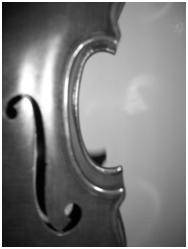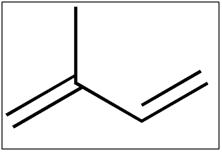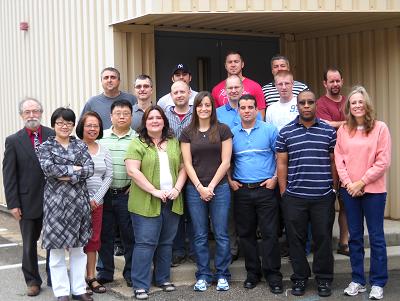Volume 8 Issue 1
Volume 8 Issue 1
What’s Happening at Missouri S&T:
(formerly UMR)
Introduction to Paint Formulation Short Course - Spring 11
Short Course Dates
We will be offering "Introduction to Coatings Composition and Specifications" July 18-20, 2011 (Summer 11), course designed for the new coatings person in areas such as sales, marketing or production. The course was initiated by a number of raw material companies and distributors requesting a course with this format. This course is not as heavily technical as is our “Basic Composition of Coatings" and “Introduction to Paint Formulation" courses. The "Introduction to Coatings Composition and Specifications" course is a two and a half day course which will discuss the types of coatings, the basic composition of coatings and the tests and specifications used by the industry. This course will allow the participant to gain the fundamentals needed to work in this industry and to communicate more clearly.
We will be offering "Basic Composition of Coatings" September 19-23, 2011 (Fall 11). The Basic Composition course is intended for new personnel in the coatings profession. It targets the components of coatings (resin, pigments, extenders, solvents and additives), testing and specifications, general formulation and manufacturing methods. Basic Composition is primarily a lecture course with several laboratory demonstrations.
We will be offering "Introduction to Paint Formulation" October 10-14, 2011 (Fall 11). This course is intended to give the person a fundamental knowledge of how to approach a starting formulation and troubleshoot it. This course involves both lecture and laboratory work.
For more information see our web site at http://coatings.mst.edu/index.html and to register contact Catherine Hancock at cemv26@mst.edu or coatings@mst.edu or call 573-341-4419. **These courses are held on the Rolla Campus**
Employment Tab
We have started an employment section for our students and companies. We have a full time job section, an intern / co-op section and a graduating and alumni students section . Please explore our section on employment on our web site. Anyone wanting to have job opening listed, please contact us at (573) 341-4419 or e-mail: svgwcc@mst.edu . You can also write to us at Missouri S&T Coatings Institute, BOM #2, 651 W. 13th St., Rolla, MO 65409-1020. Our web site is http://coatings.mst.edu
Technical Insights on Coatings Science
To Restore or Not to Restore; Analytical Techniques Lend a Hand
Catherine Hancock , Graduate Research Student, Missouri S&T
& Violin hobbyist for 16 years
When a museum or even you (if you are extremely lucky) come across a violin dating back a few hundred years, the first question asked is “Who is the authentic maker of the instrument?” The next logical question, “What condition is the instrument in after all this time?” The ideal situation for a collector would be a violin that set in a humidity-controlled room with loosened strings for 300 years. Even then damage to the violin from the pressure of the instrument against the case would most likely occur, but the air conditioning boom did not occur until the 1900s, therefore, no collectors are that fortunate.
 |
| Image 1: W. Mathis violin f hole |
Due to degradation of coatings over time, a decision must be made by the owner of the instrument on whether to have a luthier restore the varnish to its former glory or the leave the instrument untouched. This can be a stressful and costly decision, since the highest public auction bid for a Stradivarius is $3,544,000. 1 The decision to fix or recoat a violin is usually not for vanity alone, but also to maintain the quality of the instrument, giving it a longer life.
Martin Schleske has published numerous articles on the effect of primers and varnishes on the acoustics of stringed instruments. Schleske’s group uses a stereomicroscope to study the anatomy of the body and varnish of the instrument. The group determined that some coatings were indeed superior to others concerning speed of sound, resonance damping, and vibrating mass.2 A closer look at violin varnish was needed to successfully mimic and understand the properties of these instruments.
 |
| Image 2: isoprene from chemdraw |
Generally, varnishes used on violins are made up of essential oils, natural resins, gum resin and drying oils.3 Natural resins are the hardest to distinguish on old instruments because they are extracted from trees, plants or animals. The chemical composition of natural oils is time and geographically dependent. The complex structure has been narrowed to the terpenoid class. Terpenoids are multiples of the monomer isoprene and are classified as monoterpenoids (C10), sequiterpenoids (C15), diterpenoids (C20) and triterpenoids (C30).3
Raman3 and Fourier Transform Infrared (FTIR)4 have been used to aid in the identification of these resins. This instrumentation was successful in determination of functional groups and bonds, but left much to be desired in the identification of the molecular composition. A destructive technique would be necessary.
In 2008, a published study used pyrolysis coupled with gas chromatography (GC) and mass spectrometry (MS) to identify chemical markers in violin resin. In 2009, a team of luthiers and scientists used the same techniques to test several Stradivarius violins. Samples were taken in an agreed upon location on the instruments.5 This allowed researchers to determine the varnish techniques used by Stradivari.
Of course destructive techniques are not ideal, especially dealing with million dollar instruments, but the analytical tests do not need to be performed on each violin. A restoration luthier can narrow techniques and varnishes by time period with the assistance of the analytical techniques. Throughout the violin making process very little has changed, even down to the hand tools used, but scientists and luthiers are closer to understanding the small change in varnish that distinguish that 3.5 million dollar violin from a 100 dollar replica.
Reference:
(1) http://www.stradivariusviolins.org, accessed 16 June 2011.
(2) Schleske, M. On the Acoustical Properties of Violin Varnish“¿CAS Journal Vol.3, no.6, (Series II), November 1998.
(3) Chiavari, G., Montalbani, S., Otero, V. Characterization of varnishes used in violins by pyrolysis-gas chromatography/mass spectrometry. Rapid Communications in Mass Spectrometry. Vol 22, Issue 23, p. 3711–3718, 15 December 2008
(4) Bertrand, L., Robinet, L., Cohen, S. X., Sandt, C., Le Ho, A., Soulier, B., Lattuati-Derieux, A., Echard, J. Identification of the finishing technique of an early eighteenth century musical instrument using FTIR spectromicroscopy. Anal. Bioanal. Chem. 3 Oct 2010.
(5) Echard, J., Bertrand, L., Bohlen, A., Le Ho, A., Paris, C., Bellot-Gurlet, L., Thao, S., Lavedrine, B., Robinet, L., Soulier, B., Lattuati-Derieux, A., Vaiedelich, S. The Nature of the Extraordinary Finish of Stradivari’s Instruments. Angewandte Chemie International Edition. Vol 49, Issue 1, 2009.

